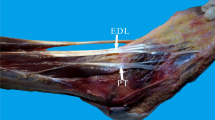Abstract
Peroneus tertius (fibularis tertius) is a muscle unique to humans. It often appears to be a part of extensor digitorum longus, and might be described as its “fifth tendon”. Although its insertion variation has been reported by many authors, variations of its origin points are not common. A variation of the peroneus tertius muscle was found during routine dissection of a 75-year-old male cadaver. The muscle originated from the extensor hallucis longus. The muscle belly of the extensor hallucis longus arose from the middle two-fourths of the medial surface of the fibula, medial to the extensor digitorum longus, and anterior surface of the interosseous membrane. It lay under the extensor digitorum longus, and lateral to the tibialis anterior muscle. The muscle belly of the extensor hallucis longus divided into medial and lateral parts 17 cm below its origin point. The lateral part, named as peroneus tertius, continued downward to reach the medial part of the dorsal surface of the base of the fifth metatarsal bone. The medial part ran also downward and divided into two tendons reaching the dorsal surface of the base of the distal phalanx of the great toe. This kind of variation may be important during foot or leg surgery.

Similar content being viewed by others
References
Arnold PG, Yugueros P, Hanssen AD (1999) Muscle flaps in osteomyelitis of the lower extremity: a 20-year account. Plast Reconstr Surg 104(1):107–110
Brody PJ, Grumbine N (1984) Peroneus tertius reconstruction for flexible clawtoes associated with cavus deformity: a preliminary report. J Foot Surg 23(5):357–361
Bryce TH (1923) Myology: Muscles of anterior region of leg and dorsum of foot. In: Schafer ES, Symington J, Bryce TH (eds) Quain’s elements of anatomy. vol 4 Part II. 11th edn. Longmans Green, New York
Dockery GL, Toothaker J, Suppan RJ (1977) A lateral ankle stabilization procedure utilizing the peroneus brevis and peroneus tertius tendons. J Am Podiatry Assoc 67(12):891–894
Gaulrapp H, Heimkes B (1997) Peroneus tertius tendon repair following old traumatic rupture of the anterior tibial tendon (casuistry). Unfallchirurg 100(12):979–983
Hollinshead WH (1982) The back and limbs. In: Anatomy for surgeons. vol 3. 3rd edn. Harper & Row, London
Joshi SD, Joshi SS, Athavale SA (2006) Morphology of peroneus tertius muscle. Clin Anat 19(7):611–614
Jungers WL, Meldrum DJ, Stern JT (1993) The functional and evolutionary significance of the human peroneus tertius muscle. J Hum Evol 25:377–386
Mehta V, Gupta V, Nayyar A, Arora J, Loh H, Suri RK, Rath G (2011) Accessory muscle belly of peroneus tertius in the leg––a rare anatomical variation with clinical relevance––utility in reconstructions. Morphologie 95(308):23–25
Romanes GJ (ed) (1978) Cunningham’s textbook of anatomy, 11th edn. Oxford University Press, London, pp 377–378
Rourke K, Dafydd H, Parkin IG (2007) Fibularis tertius: revisiting the anatomy. Clin Anat 20(8):946–949
Sammarco GJ, Carrasquillo HA (1995) Surgical revision after failed lateral ankle reconstruction. Foot Ankle Int 16(12):748–753
Sokolowska-Pituchowa J, Miaśkiewicz C, Skawina A, Makoś K (1974) Morphology and some measurements of the peroneus tertius muscle in man. Folia Morphol (Warsz) 33(2):91–103
Standring S (2008) Gray’s anatomy. 40th edn. Chapter 83, Section 9, Churchill Livingstone, London
Taşer F, Shafiq Q, Toker S (2009) Coexistence of anomalous m. peroneus tertius and longitudinal tear in the m.peroneus brevis tendon. Eklem Hastalik Cerrahisi 20(3):165–168
Wityrouw E, Borre KV, Willems TM, Huysmans J, Broos E, De Clerca D (2006) The significance of peroneus tertius muscle in ankle injuries: a prospective study. Am J Sports Med 34(7):1159–1163
Conflict of interest
The authors declare that they have no conflict of interest.
Author information
Authors and Affiliations
Corresponding author
Rights and permissions
About this article
Cite this article
Yildiz, S., Yalcin, B. An unique variation of the peroneus tertius muscle. Surg Radiol Anat 34, 661–663 (2012). https://doi.org/10.1007/s00276-011-0929-0
Received:
Accepted:
Published:
Issue Date:
DOI: https://doi.org/10.1007/s00276-011-0929-0




